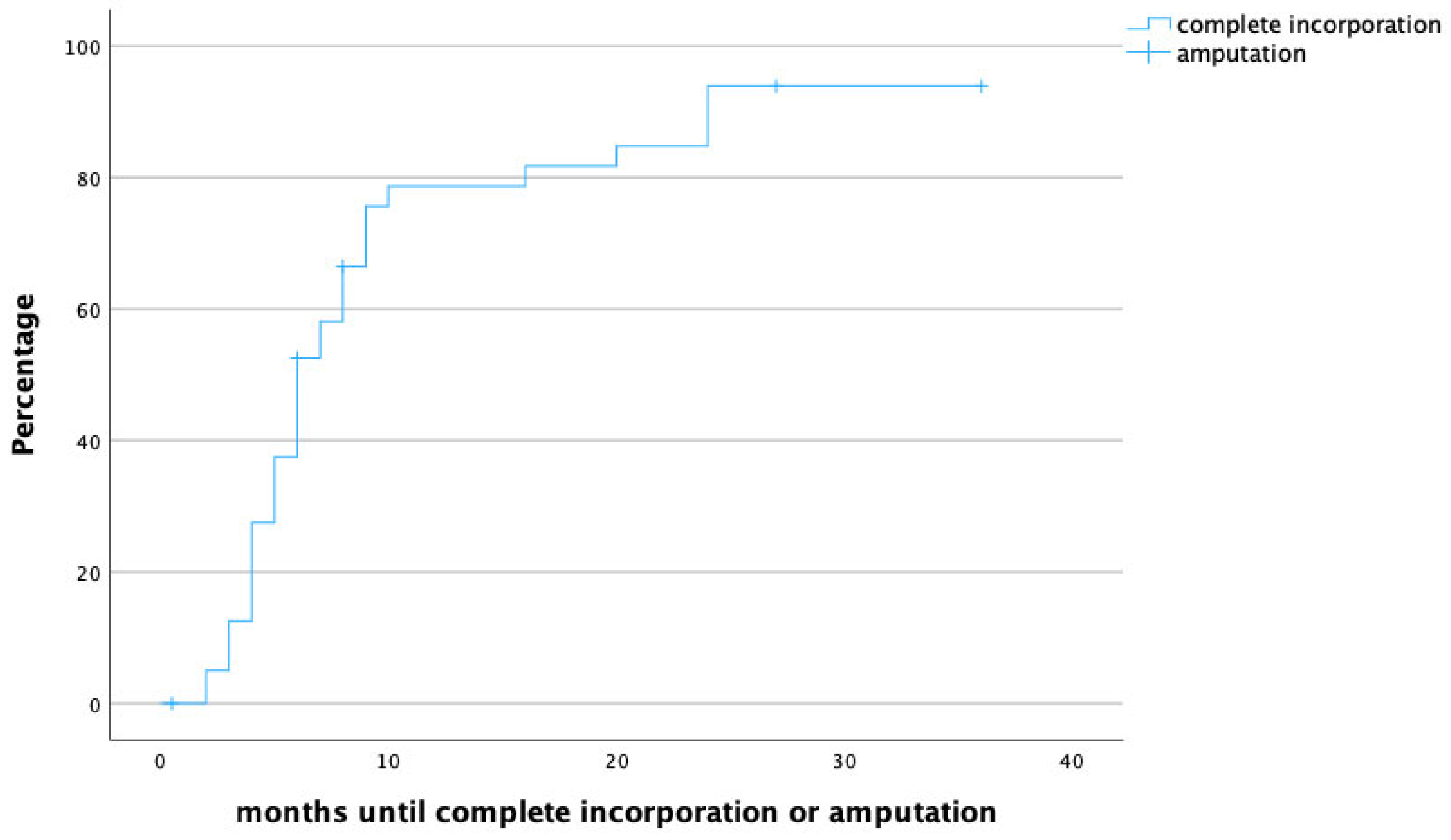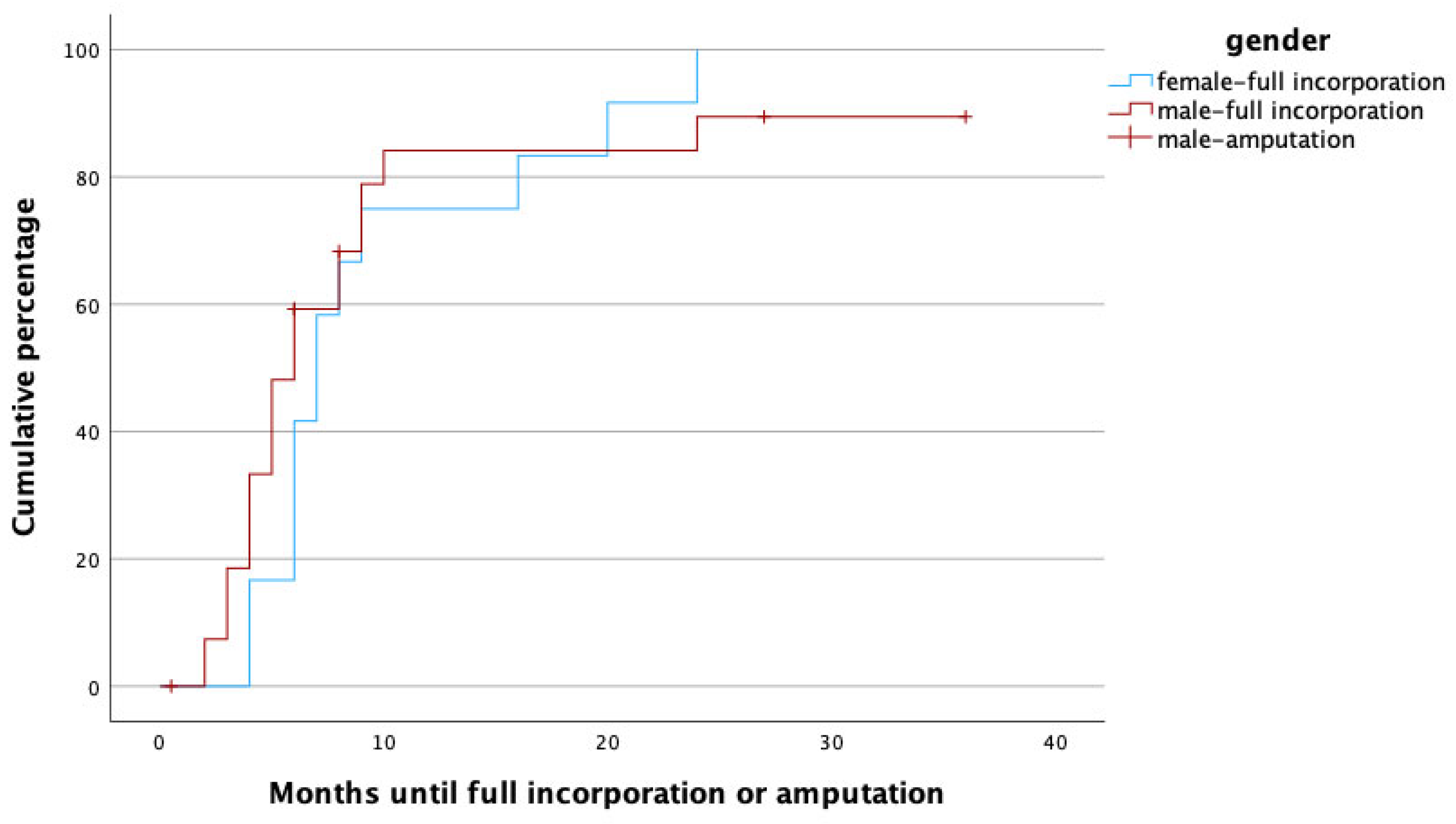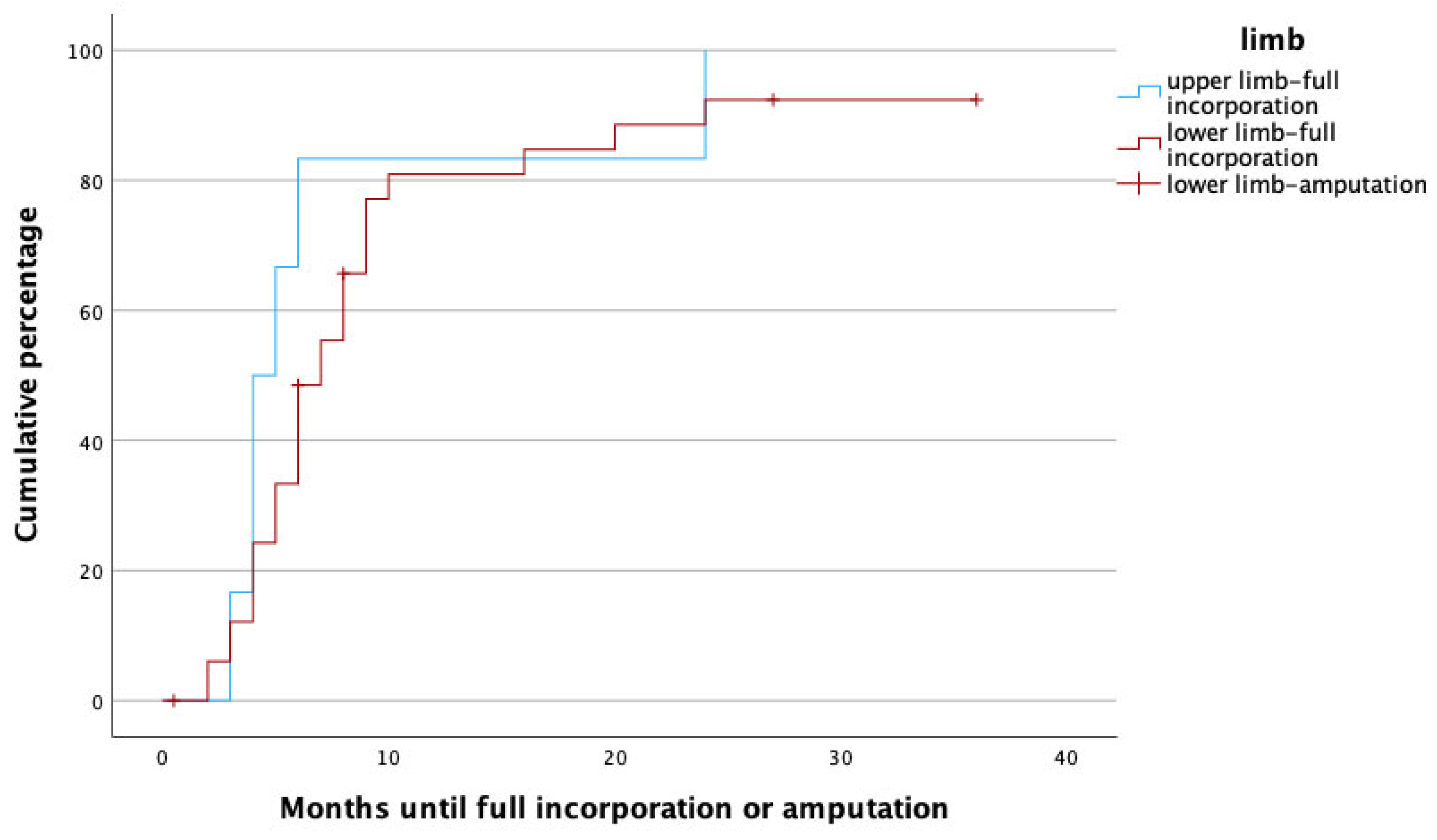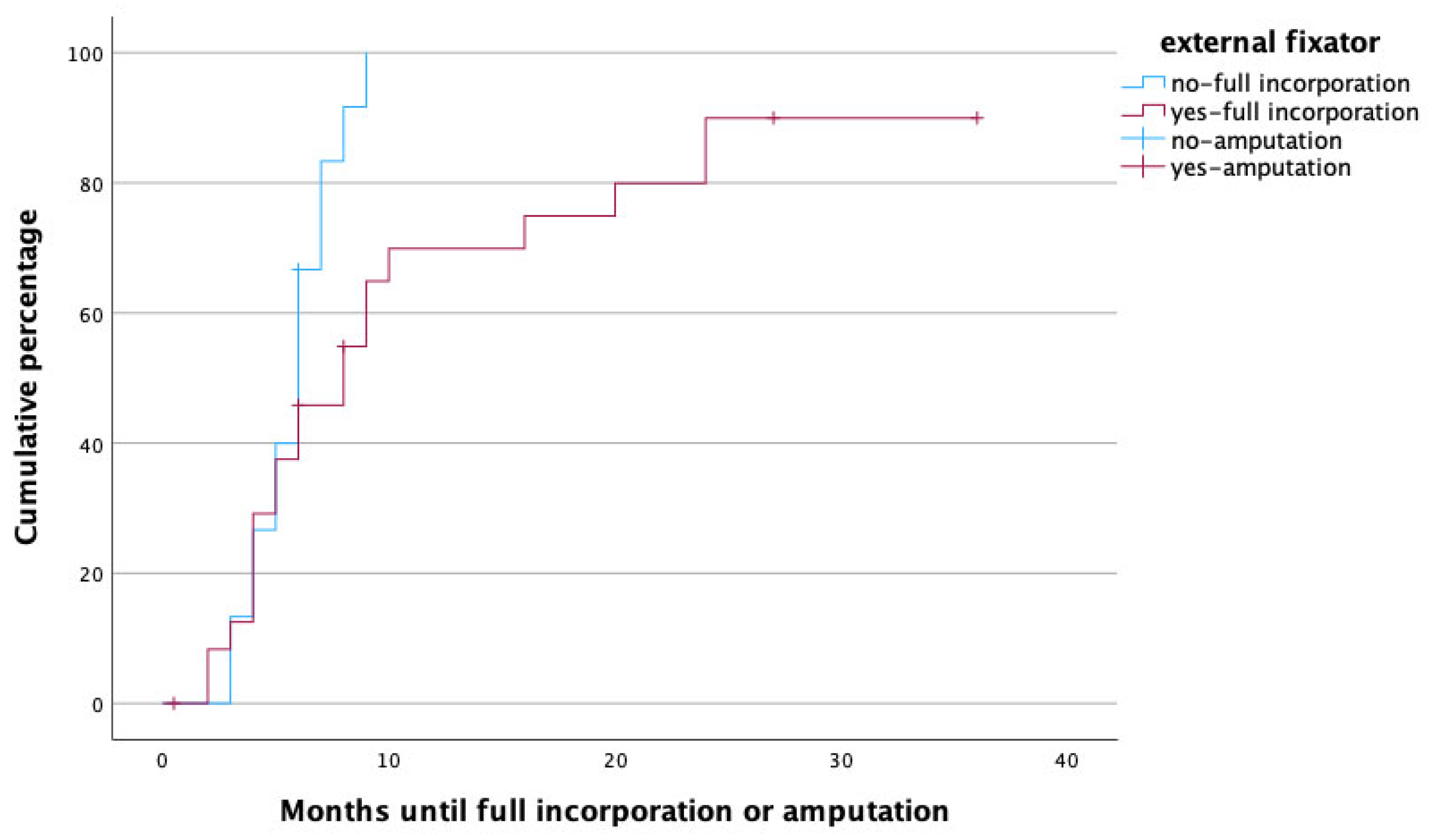The Vascularized Fibula as Salvage Procedure in Extremity Reconstruction: A Retrospective Analysis of Time to Heal and Possible Confounders
Abstract
1. Introduction
2. Patients and Methods
2.1. Study Design
2.2. Patient Preparation and Surgical Technique
2.3. Statistics
3. Results
3.1. Patients and Indications
3.2. Potential Risk Factors
3.3. Surgical Procedure
3.4. Postoperative Complications, Revision Surgeries, and Secondary Amputation Rates
3.5. Time to Heal
3.6. Confounders for Healing Time
3.7. Patients with Secondary Amputations and Risk Factor Analysis
3.8. Donor Site Morbidity
4. Discussion
5. Conclusions
- ▪
- Vascularized fibula graft is a versatile flap ideal for the reconstruction of extensive defects of long bones. Success rates are independent of patient age or treatment indication.
- ▪
- Careful patient evaluation may be necessary in the face of PAOD, as this has been associated with therapy failure and was associated with a subsequent need for amputation in our cohort.
- ▪
- With very limited donor site morbidity, vascularized fibula graft can be considered as an ideal method for the reconstruction of bone defects in the extremities if other treatment options have failed or cannot achieve comparably satisfactory results.
- ▪
- If applicable, smoking cessation should be advised, as it is a modifiable risk factor and was associated with significantly prolonged healing times in our cohort.
Author Contributions
Funding
Institutional Review Board Statement
Informed Consent Statement
Data Availability Statement
Conflicts of Interest
References
- Berrey, B.H.; Lord, C.F.; Gebhardt, M.C.; Mankin, H.J. Fractures of Allografts. Frequency, Treatment, and End-Results. J. Bone Jt. Surg. Am. 1990, 72, 825–833. [Google Scholar] [CrossRef]
- Donati, D.; Di Liddo, M.; Zavatta, M.; Manfrini, M.; Bacci, G.; Picci, P.; Capanna, R.; Mercuri, M. Massive Bone Allograft Reconstruction in High-Grade Osteosarcoma. Clin. Orthop. Relat. Res. 2000, 377, 186–194. [Google Scholar] [CrossRef]
- Hornicek, F.J.; Gebhardt, M.C.; Tomford, W.W.; Sorger, J.I.; Zavatta, M.; Menzner, J.P.; Mankin, H.J. Factors Affecting Nonunion of the Allograft-Host Junction. Clin. Orthop. Relat. Res. 2001, 382, 87–98. [Google Scholar] [CrossRef]
- Moran, S.L.; Shin, A.Y.; Bishop, A.T. The Use of Massive Bone Allograft with Intramedullary Free Fibular Flap for Limb Salvage in a Pediatric and Adolescent Population. Plast. Reconstr. Surg. 2006, 118, 413–419. [Google Scholar] [CrossRef]
- O’Connor, M.I.; Sim, F.H.; Chao, E.Y. Limb Salvage for Neoplasms of the Shoulder Girdle. Intermediate Reconstructive and Functional Results. J. Bone Jt. Surg. Am. 1996, 78, 1872–1888. [Google Scholar] [CrossRef]
- Hariri, A.; Mascard, E.; Atlan, F.; Germain, M.A.; Heming, N.; Dubousset, J.F.; Wicart, P. Free Vascularised Fibular Graft for Reconstruction of Defects of the Lower Limb after Resection of Tumour. J. Bone Jt. Surg. Br. 2010, 92, 1574–1579. [Google Scholar] [CrossRef]
- Claxton, M.R.; Shirley, M.B.; Bakri, K.; Rose, P.S.; Moran, S.L.; Houdek, M.T. Utility of the Free Vascularized Fibula Flap to Reconstruct Oncologic Defects in the Upper Extremity. Anticancer Res. 2020, 40, 2751–2755. [Google Scholar] [CrossRef]
- Lambert, K.L. The Weight-Bearing Function of the Fibula. A Strain Gauge Study. J. Bone Jt. Surg. Am. 1971, 53, 507–513. [Google Scholar] [CrossRef]
- Shi, L.L.; Garg, R.; Jawa, A.; Wang, Q.; Chai, Y.; Zeng, B.; Jupiter, J.B. Bony Hypertrophy in Vascularized Fibular Grafts. Hand 2022, 17, 106–113. [Google Scholar] [CrossRef]
- Muramatsu, K.; Hashimoto, T.; Tominaga, Y.; Taguchi, T. Vascularized Bone Graft for Oncological Reconstruction of the Extremities: Review of the Biological Advantages. Anticancer Res. 2014, 34, 2701–2707. [Google Scholar]
- Landau, M.J.; Badash, I.; Yin, C.; Alluri, R.K.; Patel, K.M. Free Vascularized Fibula Grafting in the Operative Treatment of Malignant Bone Tumors of the Upper Extremity: A Systematic Review of Outcomes and Complications. J. Surg. Oncol. 2018, 117, 1432–1439. [Google Scholar] [CrossRef]
- Muller, C.; Athlani, L.; Barbary, S.; Dautel, G. Reconstruction of the Distal Radius Using a Double-Barrel Vascularized Fibula Flap: A Case Series. Hand Surg. Rehabil. 2022, 41, 189–193. [Google Scholar] [CrossRef]
- Soucacos, P.N.; Kokkalis, Z.T.; Piagkou, M.; Johnson, E.O. Vascularized Bone Grafts for the Management of Skeletal Defects in Orthopaedic Trauma and Reconstructive Surgery. Injury 2013, 44 (Suppl. S1), S70–S75. [Google Scholar] [CrossRef]
- Van Den Heuvel, S.C.M.; Winters, H.A.H.; Ultee, K.H.; Zijlstra-Koenrades, N.; Sakkers, R.J.B. Combined Massive Allograft and Intramedullary Vascularized Fibula Transfer: The Capanna Technique for Treatment of Congenital Pseudarthrosis of the Tibia. Acta Orthop. 2020, 91, 605–610. [Google Scholar] [CrossRef]
- Ebad Ali, S.M.; Razak, S.; Khan, W.F.; Khan, S.; Khaimchandani, D.; Akhtar, U.R.; Sahito, B.; Abbasi, A.N. Outcomes of Reconstruction with Vascularized vs. Non Vascularized Bone Graft after Resection of Bone Tumours—A Systematic Review and Meta-Analysis. J. Ayub Med. Coll. Abbottabad 2023, 35, 307–312. [Google Scholar] [CrossRef]
- Alford, A.I.; Nicolaou, D.; Hake, M.; McBride-Gagyi, S. Masquelet’s Induced Membrane Technique: Review of Current Concepts and Future Directions. J. Orthop. Res. 2021, 39, 707–718. [Google Scholar] [CrossRef] [PubMed]
- Tong, K.; Zhong, Z.; Peng, Y.; Lin, C.; Cao, S.; Yang, Y.; Wang, G. Masquelet Technique versus Ilizarov Bone Transport for Reconstruction of Lower Extremity Bone Defects Following Posttraumatic Osteomyelitis. Injury 2017, 48, 1616–1622. [Google Scholar] [CrossRef]
- Brosius, F. SPSS: Umfassendes Handbuch zu Statistik und Datenanalyse; 8. Auflage; MITP: Frechen, Germany, 2018; ISBN 978-3-95845-668-6. [Google Scholar]
- Xu, L.; Wen, L.; Qiao, J.; Zhu, Z.; Qiu, Y.; Xiong, J.; Mao, H.; Wang, S. Clinical Outcome of Free Vascularized Fibula Graft in the Surgical Treatment of Extremity Osteosarcoma. Orthop. Surg. 2020, 12, 727–733. [Google Scholar] [CrossRef]
- Lefebvre, R.; Bougioukli, S.; Marecek, G.; Howard, M.; Cohen, L.; Stevanovic, M. Free Vascularized Fibula Graft for Staged Reconstruction of Infected Humerus Nonunions. J. Orthop. Trauma 2023, 37, e206–e212. [Google Scholar] [CrossRef]
- González del Pino, J.; Bartolomé del Valle, E.; Graña, G.L.; Villanova, J.F. Free Vascularized Fibular Grafts Have a High Union Rate in Atrophic Nonunions. Clin. Orthop. Relat. Res. 2004, 419, 38–45. [Google Scholar] [CrossRef]
- Toros, T.; Ozaksar, K. Reconstruction of Traumatic Tubular Bone Defects Using Vascularized Fibular Graft. Injury 2021, 52, 2926–2934. [Google Scholar] [CrossRef] [PubMed]
- Ciclamini, D.; Antonini, A.; Tos, P.; Crosio, A.; Piccato, A.; Battiston, B. Treatment of Chronic Osteomyelitis with Vascularized Bone Flaps in One-Stage-Procedure. Handchir. Mikrochir. Plast. Chir. 2020, 52, 116–122. [Google Scholar] [CrossRef]
- Guidi, M.; Guzzini, M.; Civitenga, C.; Lanzetti, R.M.; Kim, B.-S.; Besmens, I.S.; Riegger, M.; Lucchina, S.; Calcagni, M.; Perugia, D. Multifactorial Analysis of Treatment of Long-Bone Nonunion with Vascularized and Nonvascularized Bone Grafts. J. Hand Microsurg. 2023, 15, 106–115. [Google Scholar] [CrossRef]
- Kurapaty, S.S.; Hsu, W.K. Sex-Based Difference in Bone Healing: A Review of Recent Pre-Clinical Literature. Curr. Rev. Musculoskelet. Med. 2022, 15, 651–658. [Google Scholar] [CrossRef] [PubMed]
- Foley, J.P.; Fred, E.J.; Minardi, S.; Yamaguchi, J.T.; Greene, A.C.; Furman, A.A.; Lyons, J.G.; Paul, J.T.; Nandurkar, T.S.; Blank, K.R.; et al. Sex-Based Difference in Response to Recombinant Human Bone Morphogenetic Protein-2 in a Rat Posterolateral Fusion Model. Spine 2022, 47, 1627–1636. [Google Scholar] [CrossRef]
- Chang, M.A.; Bishop, A.T.; Moran, S.L.; Shin, A.Y. The Outcomes and Complications of 1,2-Intercompartmental Supraretinacular Artery Pedicled Vascularized Bone Grafting of Scaphoid Nonunions. J. Hand Surg. Am. 2006, 31, 387–396. [Google Scholar] [CrossRef]
- Tian, R.; Zheng, F.; Zhao, W.; Zhang, Y.; Yuan, J.; Zhang, B.; Li, L. Prevalence and Influencing Factors of Nonunion in Patients with Tibial Fracture: Systematic Review and Meta-Analysis. J. Orthop. Surg. Res. 2020, 15, 377. [Google Scholar] [CrossRef]
- Ortona, E.; Pagano, M.T.; Capossela, L.; Malorni, W. The Role of Sex Differences in Bone Health and Healing. Biology 2023, 12, 993. [Google Scholar] [CrossRef]
- Simon, M.H.; Grünwald, L.; Schenke, M.; Dickschas, J.; Strecker, W. Corrective Osteotomies of Femur and Tibia: Which Factors Influence Bone Healing? Arch. Orthop. Trauma Surg. 2020, 140, 303–311. [Google Scholar] [CrossRef]
- Strube, P.; Mehta, M.; Baerenwaldt, A.; Trippens, J.; Wilson, C.J.; Ode, A.; Perka, C.; Duda, G.N.; Kasper, G. Sex-Specific Compromised Bone Healing in Female Rats Might Be Associated with a Decrease in Mesenchymal Stem Cell Quantity. Bone 2009, 45, 1065–1072. [Google Scholar] [CrossRef]
- Adams, C.I.; Keating, J.F.; Court-Brown, C.M. Cigarette Smoking and Open Tibial Fractures. Injury 2001, 32, 61–65. [Google Scholar] [CrossRef] [PubMed]
- Glassman, S.D.; Anagnost, S.C.; Parker, A.; Burke, D.; Johnson, J.R.; Dimar, J.R. The Effect of Cigarette Smoking and Smoking Cessation on Spinal Fusion. Spine 2000, 25, 2608–2615. [Google Scholar] [CrossRef] [PubMed]
- Krannitz, K.W.; Fong, H.W.; Fallat, L.M.; Kish, J. The Effect of Cigarette Smoking on Radiographic Bone Healing after Elective Foot Surgery. J. Foot Ankle Surg. 2009, 48, 525–527. [Google Scholar] [CrossRef]
- Berven, H.; Brix, M.; Izadpanah, K.; Kubosch, E.J.; Schmal, H. Comparing Case-Control Study for Treatment of Proximal Tibia Fractures with a Complete Metaphyseal Component in Two Centers with Different Distinct Strategies: Fixation with Ilizarov Frame or Locking Plates. J. Orthop. Surg. Res. 2018, 13, 121. [Google Scholar] [CrossRef] [PubMed]
- Kolbenschlag, J.; Hellmich, S.; Germann, G.; Megerle, K. Free Tissue Transfer in Patients with Severe Peripheral Arterial Disease: Functional Outcome in Reconstruction of Chronic Lower Extremity Defects. J. Reconstr. Microsurg. 2013, 29, 607–614. [Google Scholar] [CrossRef]
- Bovill, J.D.; Huffman, S.S.; Deldar, R.; Sayyed, A.A.; Gupta, N.J.; Truong, B.N.; Bekeny, J.C.; Attinger, C.E.; Akbari, C.N.; Evans, K.K. Long-Term Outcomes in Patients With Peripheral Arterial Disease Who Undergo Free Flap Reconstruction for Chronic Lower Extremity Wounds. Ann. Plast. Surg. 2023, 90, 61–66. [Google Scholar] [CrossRef]
- Murphy, G.A.; Singh-Moon, R.P.; Rowe, V.L.; Patel, K.M.; Mazhar, A.; Cuccia, D.J.; Armstrong, D.G. Steal Syndrome from a Superficial Circumflex Iliac Perforator Artery Flap in a Patient with a Hypoplastic Posterior Tibial Artery and Severe Diabetic Peripheral Artery Disease. J. Surg. Case Rep. 2021, 2021, rjab067. [Google Scholar] [CrossRef]
- Babovic, S.; Johnson, C.H.; Finical, S.J. Free Fibula Donor-Site Morbidity: The Mayo Experience with 100 Consecutive Harvests. J. Reconstr. Microsurg. 2000, 16, 107–110. [Google Scholar] [CrossRef]
- Feuvrier, D.; Sagawa, Y.; Béliard, S.; Pauchot, J.; Decavel, P. Long-Term Donor-Site Morbidity after Vascularized Free Fibula Flap Harvesting: Clinical and Gait Analysis. J. Plast. Reconstr. Aesthetic Surg. 2016, 69, 262–269. [Google Scholar] [CrossRef]






| Gender | |
| Female | 13 (32%) |
| Male | 28 (68%) |
| Affected limb | |
| Upper limb | 7 (17%) |
| Lower limb | 34 (83%) |
| Surgical pretreatment | |
| Yes | 34 (83%) |
| No | 7 (17%) |
| Risk factors | |
| Obesity | 2 (5%) |
| Alcoholism | 1 (2%) |
| Malnutrition | 1 (2%) |
| Osteoporosis | 4 (10%) |
| Arterial hypertension | 4 (10%) |
| PAOD | 5 (12%) |
| Diabetes mellitus | 1 (2%) |
| Smoking | 19 (46%) |
| Giant Cell Tumor of the Bone | Congenital Deformity | Pseudarthrosis | Osteomyelitis | Traumatic Defect | |
|---|---|---|---|---|---|
| Upper extremity | |||||
| humerus | - | - | - | 2 (5) | - |
| radius | 2 (5) | - | - | 2 (5) | - |
| ulna | - | - | - | 1 (2) | - |
| Lower extremity | |||||
| femur | - | - | 2 (5) | 3 (7) | 1 (2) |
| tibia | - | 6 (15) | 6 (15) | 13 (32) | 1 (2) |
| talus | - | - | - | 1 (2) | - |
| calcaneus | - | - | - | 1 (2) | - |
| Total | 2 (5) | 6 (15) | 8 (20) | 23 (55) | 2 (5) |
| Fibula blood supply | |
| Free flap, n (%) | 23 (56) |
| Pedicled proximally, n (%) | 16 (39) |
| Pedicled distally, n (%) | 2 (5) |
| Fibula configuration | |
| Single-barrel, n (%) | 28 (68) |
| + Fibula head included, n (%) | 3 (7) |
| Double-barrel, n (%) | 13 (32) |
| Flap design | |
| Osseous, n (%) | 15 (36.5) |
| Osteocutaneous, n (%) | 25 (61) |
| Osteomyocutaneous, n (%) | 1 (2.5) |
| Osteosynthesis | |
| External fixation, n (%) | 25 (61) |
| Internal fixation, n (%) | 16 (39) |
| Intramedullary nail, n (%) | 1 (2.5) |
| Plate, n (%) | 14 (34) |
| Screws only, n (%) | 1 (2.5) |
| Median defect length in cm (IQR; range) | 8 (6.15–12.35; 1.5–24.6) |
| Median fibula length in cm (IQR; range) | 13 (8–22.5; 2–30) |
| Median surgery time in hours (IQR; range) | 7.5 (6.3–10; 2.3–18.2) |
Disclaimer/Publisher’s Note: The statements, opinions and data contained in all publications are solely those of the individual author(s) and contributor(s) and not of MDPI and/or the editor(s). MDPI and/or the editor(s) disclaim responsibility for any injury to people or property resulting from any ideas, methods, instructions or products referred to in the content. |
© 2024 by the authors. Licensee MDPI, Basel, Switzerland. This article is an open access article distributed under the terms and conditions of the Creative Commons Attribution (CC BY) license (https://creativecommons.org/licenses/by/4.0/).
Share and Cite
Smolle, C.; Holzer-Geissler, J.C.J.; Mandal, P.; Schwaller, J.; Petje, G.; Rois, J.; Kamolz, L.-P.; Girsch, W. The Vascularized Fibula as Salvage Procedure in Extremity Reconstruction: A Retrospective Analysis of Time to Heal and Possible Confounders. Life 2024, 14, 318. https://doi.org/10.3390/life14030318
Smolle C, Holzer-Geissler JCJ, Mandal P, Schwaller J, Petje G, Rois J, Kamolz L-P, Girsch W. The Vascularized Fibula as Salvage Procedure in Extremity Reconstruction: A Retrospective Analysis of Time to Heal and Possible Confounders. Life. 2024; 14(3):318. https://doi.org/10.3390/life14030318
Chicago/Turabian StyleSmolle, Christian, Judith C. J. Holzer-Geissler, Patrick Mandal, Jessica Schwaller, Gert Petje, Johannes Rois, Lars-Peter Kamolz, and Werner Girsch. 2024. "The Vascularized Fibula as Salvage Procedure in Extremity Reconstruction: A Retrospective Analysis of Time to Heal and Possible Confounders" Life 14, no. 3: 318. https://doi.org/10.3390/life14030318
APA StyleSmolle, C., Holzer-Geissler, J. C. J., Mandal, P., Schwaller, J., Petje, G., Rois, J., Kamolz, L.-P., & Girsch, W. (2024). The Vascularized Fibula as Salvage Procedure in Extremity Reconstruction: A Retrospective Analysis of Time to Heal and Possible Confounders. Life, 14(3), 318. https://doi.org/10.3390/life14030318







